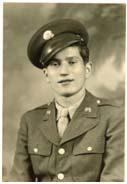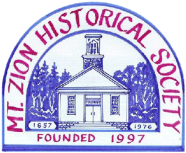Remembering
Private Harry Edward Harrison (1925 - 1944)

Bronze Star Recipient, KIA

Remembering - Private Harry Edward Harrison by Ralph L. Harrison
Harry Edward Harrison was born in the village of Dents Run, Benezette Township, Elk County, Pennsylvania, on January 2, 1925, the son of William and Francis Harrison.
Harry had two brothers, James the oldest who now lives in Emporium and Ralph the youngest who lives in Dents Run. Both served in the navy during and after the war, two sisters Eva Harrison Overturf, now deceased and Shirley Harrison Burke now of Mt. Zion, and two half sisters Martha Harrison Dick, Lula Harrison Tyler and half brother William all deceased.
Harry attended the Dents Run Grade School and graduated from the Benezette High School in May 1942. After graduation he worked briefly for the Pennsylvania Railroad at Driftwood, Pa., and later in the Niagara Falls area of New York
Like almost all boys and young men in this area during this time, the end of the Great Depression and the start of World War II, Harry grew up hunting and fishing.
Making a living was hard both jobs and money were scarce. The only way most rural boys could earn any money was by hunting, fishing, trapping or digging ginseng, a medicinal root used to cure a wide variety of human aliments.
Hunting and fishing not only provided food for the table but also was part of the local culture, a way of life for most people. Nearly everyone hunted and virtually every household had one or more firearms. The term gun control was never heard and if it was used it would have meant how steady ones aim when holding a rifle or shotgun is.
Many of the older boys and even some of the younger ones carried a firearm and hunted as they walked to school. When they arrived, it was unloaded and stacked in the corner. At the end of the day, it was reloaded for the walk home. Such behavior today would make the national news.
Harry was an excellent shot with both a rifle and shotgun and won high honors for his skills on the rifle range after he entered the army. On of his most prized possessions was a 32 caliber Special Marlin Rifle that he bought with money earned by hunting and trapping. The rifle is still in the family collection of firearms.
Harry was inducted into the army in May 1943 and received his basic training at Ford Leonard Wood, Missouri, and advanced combat engineer training at Fort Belvoir, Virginia. In late October 1943, he was granted nine days leave, which he spent at home before reporting to Fort Dix, New Jersey. He was immediately shipped overseas and arrived in Great Britain in late November. From December 1943 until June of 1944, he constantly trained in combat engineer tactics for what all new would be the inevitable invasion of France.
He was a member of Company C, 2nd Engineer Battalion, attached to the 28th Keystone Division known as the “Bloody Bucket Division” for their red keystone patch. Being a combat engineer was a dangerous assignment as the men were under almost constant fire. In some cases, they were called upon to take out enemy strong points ahead of the infantry.
Harry landed on the beachhead in Normandy, France on D Day +1 and was in continuous combat for seventeen days until he was killed in action June 24, 1944 at the age nineteen.
There is little information available on what he experienced during this period, as far as is known, he only wrote one letter home saying he was okay, very busy, had seen many terrible things and would write again as soon as conditions got better. No other letters was received for over a month. Then on July 24, exactly one month after he was killed, what all parents and family feared most, the dreaded telegram from War Department stating in part “We regret to inform you that your son was killed in action on June 24, 1944” and that more information would be forwarded as soon as possible as soon as it becomes available. Later a letter was received from his commanding officer stating that Pvt. Harry Harrison had volunteered to provide covering fire for his company as they dug in their positions for the night. It further stated that he was killed instantly by small arms fire and was buried in a temporary cemetery near St. Lo, Normandy, France. The letter added, “You have the deepest sympathy of the officers and men of this battalion in your bereavement. All members of this command held Pvt. Harrison in high regards. He was a splendid soldier and his exemplary behavior was an inspiration to his fellow soldiers. His many friends will feel his loss. For gallantry and bravery in action your son has been awarded the Bronze Star Metal.”
Later Harry’s remains were removed to a permanent cemetery near St. Lo in Normandy, France. At the end of the war, the United States Government gave all of the next of kin service men killed abroad the option of turning their remains to this country or any place they desired. Harry’s parents choose to have his body returned home.
Harry’s remains arrived from France in February 1948. His body was among the very first of hundreds of thousands to be returned to their homeland, a process that would require many years. Since Harry’s was one of the first bodies of a soldier to be returned from overseas after the war, there was some initial concern about the proper procedure and protocol to be observed.
The Geer Funeral Home of Penfield, Pa., was in charge of arrangements, and quickly addressed the issue of proper protocol allowing the service to be conducted as smoothly as one could hope for a family grieving the loss of a beloved son.
The funeral with full military honors for Pvt. Harrison E. Harrison was held on February 14, 1948. His final resting place was Morningside Cemetery, Dubois Pennsylvania.
The firing squad and colors were furnished by Battery A, 229th Field Artillery. Some of the men taking part in the ceremony fought over the very same terrain, the infamous hedgerow country of Normandy, France where Harry was killed along with thousands of other American soldiers.
Lest we forget…
